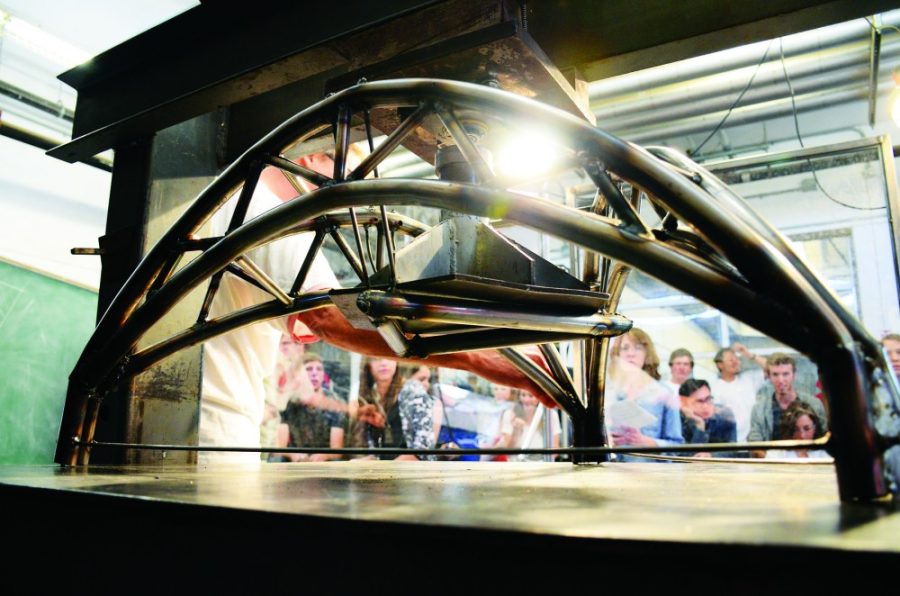“Let’s play name the structural concept!”
After the 10-pound load frame crafted of cables and welded metal was settled into the hydraulic press, awaiting thousands of pounds of pressure, assistant architecture professor Chris Trumble paused to give his class a chance to analyze its parts.
One student offered up tension as a major factor of the structure; another brought up the triangular forms present. Trumble then diagramed parts of the structure, such as its three-hinged arch, and discussed how they function to support weight and where they might fail.
“Look at it,” Trumble said. “Imagine how it’s going to deform. Why?”
The students then took their places behind the plexiglass to watch as the mass applicator began crushing one group’s structure, or what Trumble calls a surrogate for architectural volume.
One of the cables soon snapped, and the whole structure crumpled.
“They are destroyed when we’re done,” said Katie Roch, a third-year architecture student.
Building Technology 5-Structures 2 is a required course for the architecture major, which is a five-year program. The class’ goal is to cultivate an understanding of structural theory and methods of analysis in regards to architecture. The class also incorporates a six-week-long laboratory project in which small groups of students manufacture three editions of a full-scale small structure to withstand thousands of pounds of pressure.
Trumble emphasized the importance of giving his students multiple attempts to craft a structure to hold up under the pressure.
“If students are expected to learn, they must be given the opportunity to explore and experiment,”
Trumble said. “They must also be given the opportunity to improve.”
Each iteration of the project has the same process and concept, but the repetition allows students to identify the shortcomings in their early structures and create one that has resolved the issues.
The three stages have different objectives and focus on encouraging students’ growth: The first iteration revolves around concept, the second deals with specificity and by the third iteration, the goal is for students to have built a structure that is efficient.
According to Roch, a successful structure can withstand around 6,000 pounds per square inch, but she added that there’s no requirement for how much force the structures can handle.
“It’s not like whoever does the most force is the best,” Roch said. “It’s just whether or not you were able to resolve the forces and your machine makes sense.”
The class is driven by Trumble’s desire to teach conceptually, and, therefore, there is no definite failure or success. In the first iteration, which Trumble calls a festival of tragic failures, about a fourth of the structures could not even fit into the hydraulic press. However, by the third iteration, destructive testing session, which took place Thursday, the students’ growth blew him away.
“This is about creativity in a technical problem,” Trumble said. “It’s not about the numbers; it’s about the concepts.”
Although building structures such as these might not be directly applicable to some of the students’ desired career paths, the topics covered in the class are relevant to multiple areas of architecture .
“[The class] helps us to view structure as not just something you need to fulfill a requirement, but as something that can be creative and expressive and that can be part of your architecture,” said Kevin Yingst, a third-year architecture student.
One of the central ideas that Trumble wants his students to take away from his class is to not discount architecture’s importance.
“Technology in architecture is not solely the purview of the engineers,” Trumble said. “It is accessible and pregnant with qualitative as well as quantitative architectural potential. … The students have not only an opportunity but an obligation to participate in the shaping of its trajectory.”








